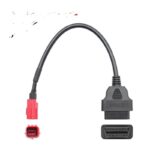The diagnostic trouble code (DTC) P0463 indicates a problem with your vehicle’s fuel level sensor circuit. Specifically, it signifies a high input voltage, suggesting a fault within the system responsible for measuring and reporting your fuel level. Understanding this code is crucial for accurate diagnosis and repair. This article provides a comprehensive overview of the P0463 code, including its meaning, symptoms, causes, and possible solutions.
Understanding the P0463 Code
The fuel level sensor, typically integrated with the fuel pump module inside the fuel tank, uses a float connected to a resistor. As fuel levels change, the float moves across the resistor, altering the resistance and consequently the voltage signal sent to the powertrain control module (PCM) or instrument cluster module. A P0463 code is triggered when the voltage signal exceeds the expected range (often above 5 volts) for a specific duration. This high voltage indicates a potential issue within the fuel level sensing circuitry.
Recognizing the Symptoms of a P0463 Code
A P0463 code can manifest in several ways, including:
- Illuminated Malfunction Indicator Lamp (MIL): Also known as the “check engine” light.
- Erratic Fuel Gauge Readings: The fuel gauge may fluctuate wildly, display inaccurate readings, or show empty even with fuel in the tank.
- Premature Low Fuel Warning: The low fuel light might illuminate and the accompanying alarm might sound even when the fuel tank is not low.
Common Causes of a P0463 Code
Several factors can contribute to a P0463 code:
- Open or Shorted Signal Circuit: Damage to the wiring connecting the fuel level sensor to the PCM can result in an open circuit (broken connection) or a short circuit (unintended connection to battery voltage).
- Faulty Ground Connection: A poor ground connection due to rust, corrosion, or a missing ground strap can disrupt the voltage signal.
- Damaged Fuel Tank: Physical damage to the fuel tank might impact the fuel level sensor or its circuitry.
- Defective Fuel Level Sensor: The sensor itself may malfunction due to internal component failure.
- Faulty Instrument Cluster: In some cases, the issue might lie with the instrument cluster’s inability to interpret the sensor signal correctly. Though less common, problems within the PCM or fuel pump control module could also trigger this code.
Diagnosing and Resolving a P0463 Code
Troubleshooting a P0463 code involves a systematic approach:
- Visual Inspection: Begin by inspecting the fuel tank, wiring harness, and connectors for any visible damage, loose connections, or corrosion. Pay particular attention to the ground connection.
- Voltage and Resistance Tests: Use a multimeter to verify the voltage supply to the sensor and check for any open circuits or shorts in the wiring. A voltage drop test on the ground circuit can reveal high resistance.
- Ground Circuit Check: Ensure a solid ground connection by cleaning or replacing the ground strap.
- Sensor Testing: Test the fuel level sensor’s resistance at varying fuel levels to determine if it’s functioning correctly. This often involves grounding the sensor wire and observing the fuel gauge response.
- Component Replacement: If testing reveals a faulty sensor, wiring, or connector, replace the defective component.
Conclusion
The P0463 code signifies a problem with your vehicle’s fuel level sensor circuit, potentially leading to inaccurate fuel gauge readings and unnecessary warnings. Addressing this issue promptly is important to avoid running out of fuel unexpectedly. While diagnosing the root cause may require some technical expertise, understanding the code and its potential causes can empower you to effectively communicate with a mechanic and ensure a proper repair. Remember to consult your vehicle’s specific repair manual for detailed diagnostic procedures and wiring diagrams.

